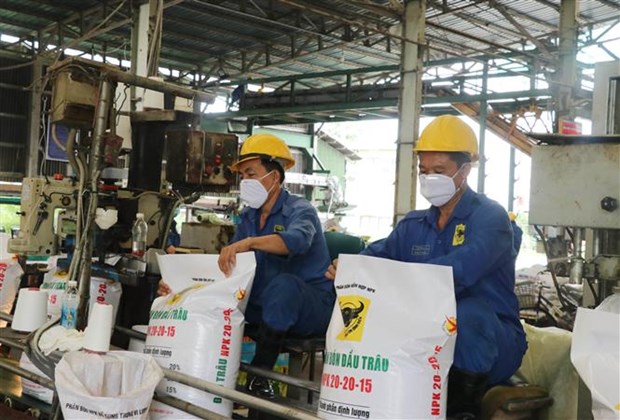 Economy
Economy


|
| Fertilisers produced at Bình Điền Fertiliser Joint Stock Company. Domestic fertiliser prices set a new high in the past 50 years.— VNA/VNS Photo Bùi Giang |
HÀ NỘI — The Russia–Ukraine conflict is forcing Việt Nam to look for alternative suppliers of fertilisers to cope with the shortage of supply and rising prices.
According to the Ministry of Agriculture and Rural Development, the Russia–Ukraine conflict is badly affecting the fertiliser market, which had already been suffering supply shortage and price increase from the prolonged COVID-19 pandemic as the supply chain was disrupted.
Russia was one of the world’s major low-cost fertiliser exporters, ranking first in urea, NPK, among nitrate export, third in potash and fourth in phosphate.
Late last week, Russia’s trade and industry ministry recommended that the country’s fertiliser producers temporarily halt exports in a move that threatened to shock the global market.
China, a significant fertiliser exporter, tightened the export of 29 types of plant nutrition from mid-October last year to cope with the domestic shortage.
Domestic fertiliser prices set a new high in the past 50 years. According to the ministry, fertiliser prices rose by more than 20 per cent in recent months. The soaring prices of oil and gas, which accounted for a significant part of production cost, also pushed up fertiliser prices.
The storm of fertiliser prices was forecast to continue when these export restrictions were still in place, causing a severe shortage of fertilisers, including potash and DAP.
Vinacam Group Joint Stock Company, one of Việt Nam’s leading fertiliser importers, said that quotations of urea at US$540-560 per tonne were all cancelled. Suppliers from Egypt increased quotation prices by $140 to $730 per tonne.
This meant that in the short term, urea might climb to around $800-1,000 per tonne in April if the oil price reaches $150 per barrel. DAP was forecast to reach $950 per tonne in April and hit $1,200-1,500 soon.
Vinacam predicted that the domestic market would see a severe shortage of DAP in the second quarter, and its price could soar to VNĐ25 million per tonne. Urea could return to the record of VNĐ18 million per tonne set in 2021.
For potash, Việt Nam relied entirely on imports. Vinacam said that potash price might soon hit VNĐ15-20 million per tonne and set a new high of around VNĐ24-25 million.
The skyrocketing prices of fertilisers are pushing farmers into a cost crisis, threatening to push up food prices. Fertilisers accounted for around 40-60 per cent of the input cost of agricultural production. Worse, fertiliser prices soured when the summer-autumn crop was coming in April and May.
The ministry pointed out that Việt Nam uses around 10 million tonnes of fertilisers each year. Last year, the country consumed 10.7 million tonnes, up by 4.67 per cent over 2020, the ministry pointed out, forecasting the domestic demand for fertilisers was stable this year.
Domestic producers could supply major fertiliser products like phosphate, urea and NPK to meet the domestic demand.
Domestic DAP production could meet around 60 per cent of demand while potash and SA fertilisers were entirely dependent on imports.
The Plant Protection Department said that it would keep a close watch on the global and domestic fertiliser market to timely raise measures to ensure agricultural production, urging import companies to look for alternative fertiliser suppliers, especially potash.
The agriculture ministry urged the Ministry of Industry and Trade to consider lifting the imposition of trade defence measures on imported DAP and MAP while enhancing market inspections to prevent speculation and fake and low-quality fertiliser.
The agriculture ministry said it was also necessary to review tax policies on fertilisers.
It also said that farmers should increase the application of new farming techniques to reduce chemical fertilisers and replace them with organic fertilisers.
The ministry’s statistics showed that Việt Nam must import around 2.7-3.5 million tonnes of fertilisers each year, of which potash accounted for 25-28 per cent and SA 25-31 per cent.
The fertiliser import from Russia made up around 130,000-380,000 tonnes, accounting for 3-9.5 per cent of Việt Nam’s fertiliser imports, mainly potash, NPK and DAP.
Last year, Việt Nam imported more than 5.1 million tonnes, 31.1 per cent of which was SA, and 25.3 per cent was potash. Potash was imported from 30 markets. Việt Nam imported 320,000 tonnes of fertilisers from Russia in 2021, mostly potash with 195,000 tonnes, accounting for more than 15 per cent of potash import.
In the first two months of this year, Việt Nam imported more than 706,000 tonnes, 73,800 tonnes of which came from Russia worth $40 million. Potash import from Russia accounted for 18 per cent of the country’s potash import in the period. — VNS